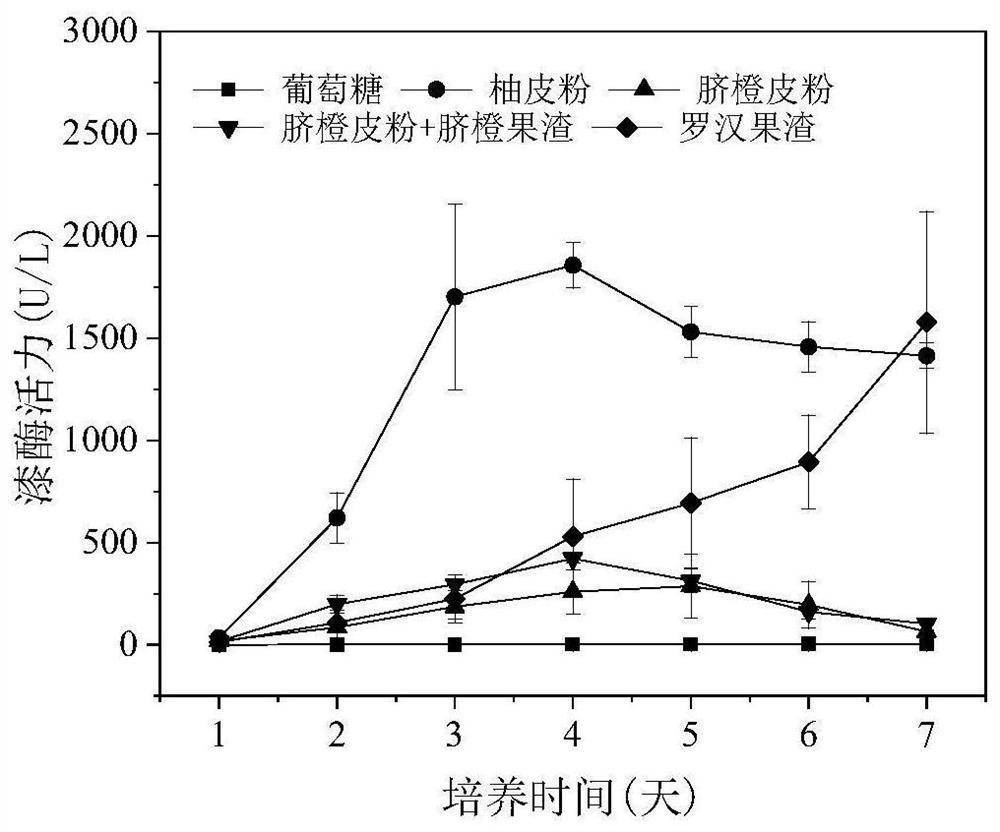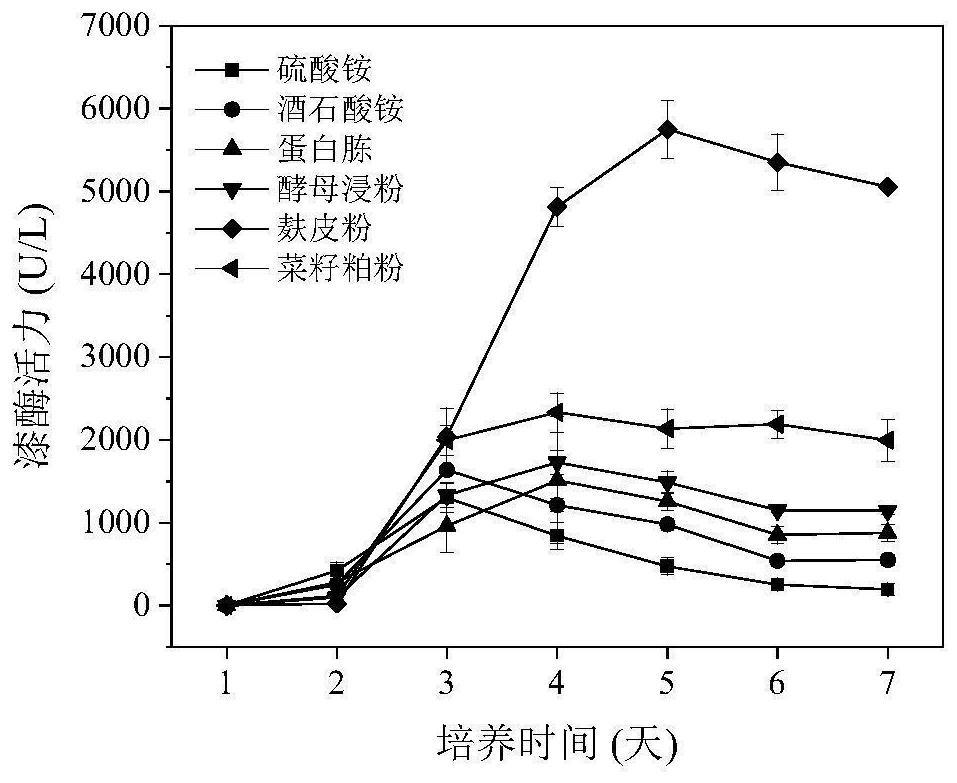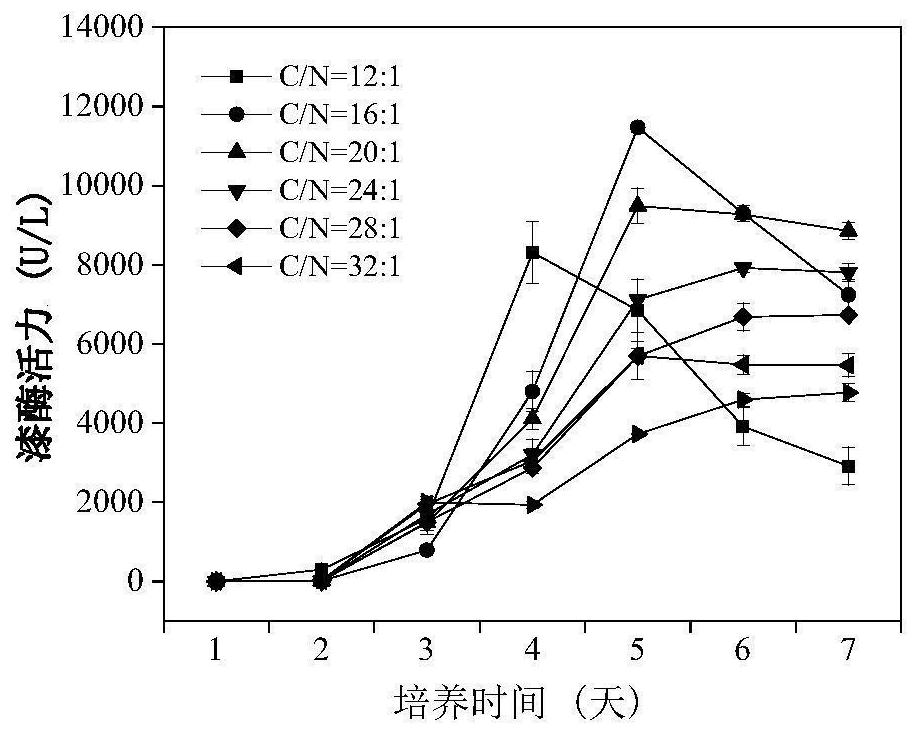Method for promoting coriolopsis gallica to produce laccase by using food waste
A waste and food technology, applied in the field of microbial enzymology, can solve the problems of long fermentation cycle, low production level, high production cost, etc., and achieve the effects of promoting growth, reducing production cost, and shortening the fermentation cycle
- Summary
- Abstract
- Description
- Claims
- Application Information
AI Technical Summary
Problems solved by technology
Method used
Image
Examples
Embodiment 1
[0021] The impact of embodiment 1 different carbon sources on the production of laccase by P.
[0022] Using the commercial carbon source glucose as a control, the effects of different peel and pomace raw materials as carbon sources on the induction of laccase production by Inonotus pilosa were investigated, including the following steps:
[0023] (1) Pretreatment of food waste: drying various peel and pomace waste raw materials at 60°C until the water content is lower than 10%, crushing, passing through a 60-mesh sieve, and sealing and storing;
[0024] (2) Preparation of seed solution: pick a ring of hyphae from the preserved slant of P. pilosa and insert it into a sterile 150mL Erlenmeyer flask equipped with 50mL liquid PDA medium and a magnetic stirrer, at 28°C, Shake the flask at 120rpm until the bottle is covered with mycelial balls, use magnetic stirring to break up the mycelial balls, pour the bacterial liquid into a sterile 50mL centrifuge tube, centrifuge at 10000rpm...
Embodiment 2
[0028] The influence of embodiment 2 different nitrogen sources on the laccase production of Inonotus pilosa
[0029] Adopt the method of embodiment 1, preferably pomelo peel powder is carbon source, design is nitrogen source with bran powder, rapeseed meal powder, peptone, yeast extract powder, ammonium sulfate, ammonium tartrate, investigates the nitrogen source of different sources to coarse hair leather The effect of laccase production by Poriobacterium.
[0030] The result is as figure 2 The results show that bran powder has the best induction effect on the laccase produced by the fermentation of Inonotus roughae, and the maximum laccase activity was obtained after 5 days of fermentation, reaching 5865U / L, which was significantly higher than that of other treatment groups, followed by rapeseed meal powder, The enzyme activities of the other commercial nitrogen source groups were all low. The induction effects of bran powder and rapeseed meal powder were significantly h...
Embodiment 3
[0031] The influence of embodiment 3 different carbon-nitrogen ratios produce laccase by P.
[0032] Using the method of Example 1, the pomelo peel powder was preferably used as the carbon source, and the bran powder was used as the nitrogen source to investigate the effects of different carbon-to-nitrogen ratios on the production of laccase by P.
[0033] According to JY / T 017-1996 method, adopt elemental analyzer to measure the total carbon of pomelo peel powder and bran powder, total nitrogen content (result is shown in table 1), adjust the addition amount of pomelo peel powder and bran powder, make The carbon-nitrogen ratios of the mixed materials are 12:1, 16:1, 20:1, 24:1, 28:1, 32:1 respectively.
[0034] Table 1 The total carbon and total nitrogen components of pomelo peel powder and bran powder
[0035] Total Carbon (%) Total nitrogen (%) carbon to nitrogen ratio pomelo peel powder 41.35 1.00 41.35 bran powder 40.37 3.30 12.23
[...
PUM
 Login to View More
Login to View More Abstract
Description
Claims
Application Information
 Login to View More
Login to View More - R&D
- Intellectual Property
- Life Sciences
- Materials
- Tech Scout
- Unparalleled Data Quality
- Higher Quality Content
- 60% Fewer Hallucinations
Browse by: Latest US Patents, China's latest patents, Technical Efficacy Thesaurus, Application Domain, Technology Topic, Popular Technical Reports.
© 2025 PatSnap. All rights reserved.Legal|Privacy policy|Modern Slavery Act Transparency Statement|Sitemap|About US| Contact US: help@patsnap.com



